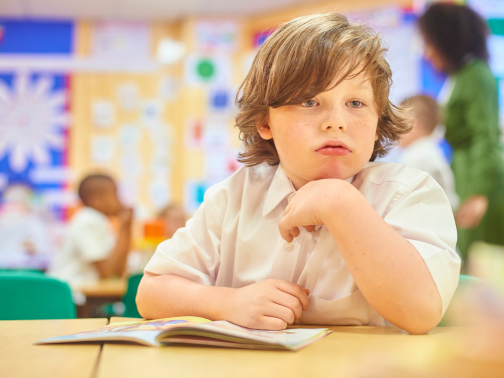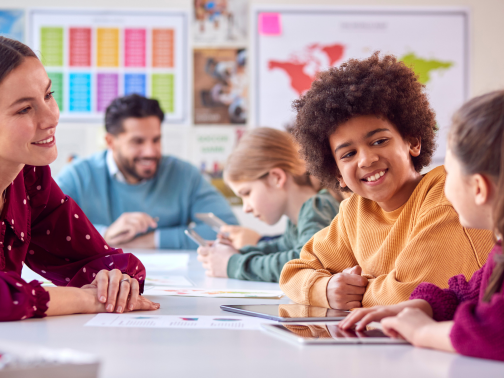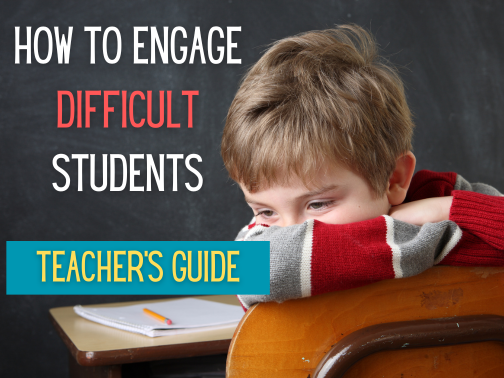Contents
Toggle
Meet David De’ Ath, founder, editor, and writer at Wonderful World English. With his extensive background as an English teacher, David provides valuable insights and practical tips on ESL for students and teachers alike.
Engaging students who face difficulties in the educational setting is integral to teaching.
Educators are likely to encounter a range of behaviors, from disengagement to disruptive conduct, within every classroom, which can challenge the learning environment.
Educators must craft an inclusive atmosphere, ensuring that every student receives the support he or she needs to thrive academically and socially.
Engaging challenging students requires dedication and strategy. Key approaches include building a positive learning environment, building strong bonds, applying effective classroom management, and collaborating with parents. Personalized attention and perseverance are vital in unlocking each student’s potential.
Drawing from my years of teaching experience and reflecting on my own past as a student who once faced similar challenges, I’ve gathered practical and effective strategies to help engage these students.
Using a combination of well-established techniques, teachers can successfully connect with students who require additional attention.
Strategies such as fostering positive relationships, tailoring instruction to meet diverse needs, and employing innovative classroom management methods are crucial.
In addition, leveraging technology and involving family members can also play a significant role in student engagement, especially in times of ongoing changes due to the pandemic.
Key Takeaways
- Teachers must create inclusive environments for all students, including those facing challenges.
- A blend of personalized strategies and strong relationships is key to engaging difficult students.
- Collaboration with families and the use of technology enhance learning experiences.

Engaging Difficult Students
Working with students who are considered difficult can be a complex task, requiring a thoughtful approach.
This guide aims to provide educators with practical, effective strategies for safely and supportively connecting with and engaging these students.
Here, you’ll find insights and methods tailored to help you navigate these students’ unique challenges, enhancing their learning experience and teaching effectiveness.
Let’s explore these strategies together and make a meaningful difference in your classroom:
1. Deciphering Student Behaviors
Teachers often face the challenge of addressing students whose conduct poses difficulties.
Understanding the root of such behaviors is fundamental to engagement.
Students demonstrating disruptive behaviors, such as lack of participation, defiance, or outbursts, may be coping with underlying personal, educational, or social challenges.
Adopting an empathetic perspective and recognizing these factors can guide educators to modify their approach, resulting in a more supportive and effective learning environment.
Initial steps include conversing with the student or engaging with their family to unearth underlying issues and forming a plan to address them constructively.
2. Crafting a Welcoming Sphere
Establishing a nurturing educational climate is pivotal for managing disruptive behaviors.
Setting clear, age-appropriate guidelines aids in preventing behavioral triggers.
Upholding these expectations consistently ensures a secure, orderly environment.
A positive atmosphere accentuated by a culture of respect, empathy, and collaboration can significantly increase student engagement and participation.
A classroom environment that feels warm and positive can significantly boost student engagement and participation.
For more insights on how to effectively build such a positive classroom culture, refer to the detailed guide below:
Related: How to Build a Positive Classroom Culture – Teacher’s Tips

3. Cultivating Trusting Rapport
Positive connections between educators and students can transform the classroom experience.
Teachers are encouraged to actively listen and demonstrate empathy towards students, thus fostering a trusting relationship.
Feeling supported can decrease students’ likelihood of disengagement.
Personalized interactions, recognizing emotional needs, and offering constructive, progress-focused feedback can further cement these relationships.
4. Embracing Adaptability
A flexible approach to education—differentiated instruction—can address individual students’ learning preferences and capacities.
Incorporating hands-on activities, visual supports, and digital tools can render teaching more accessible. Integrating students’ interests into the curriculum engages their attention and underscores the material’s relevance.

5. Establishing Structured Dynamics
Sound classroom management is integral for engaging students who present behavioral challenges.
Consistency with rules and expectations underpins classroom stability.
Teachers can create a secure environment conducive to learning by supporting positive student behaviors and establishing familiarity through routines.
Celebrating student achievements through positive reinforcement can raise self-esteem and inspire continued good behavior, positively influencing the classroom setting.
6. Fostering an Interactive Environment
Encouraging students to take an active role in their learning process can mitigate negative behaviors.
Employing varied teaching methods, such as discussions, cooperative projects, and interactive tasks, can amplify students’ engagement with the material.
Group activities enhance critical thinking and cooperation, making the classroom experience more dynamic and appealing.

7. Integrating Technology
Leveraging technological tools in teaching can captivate students’ interests and cater to different learning styles.
Digital applications, educational software, and online resources present novel ways for students to explore and absorb information.
A technologically enriched learning environment can motivate students, particularly those less responsive to traditional teaching methods.
8. Employing Diverse Techniques
Using alternative assessment methods allows educators to measure student progress in ways that align more closely with individual learning styles and abilities.
Projects, presentations, and portfolios allow students to showcase their knowledge and skills in unique formats.
These alternatives can provide a more comprehensive perspective on student capabilities and foster a sense of accomplishment.

9. Partnering with Families
Teachers should endeavor to involve parents and guardians in the educational process, creating a collaborative support system.
Maintaining consistent communication and working together can reinforce positive behaviors and enhance students’ learning experiences.
Parental involvement is crucial as it extends educational support beyond the classroom.
10. Accessing School Support Systems
Addressing the needs of challenging students often requires additional support from within the educational institution.
Resources such as counselors, special education services, and peer mentoring can offer critical assistance.
Teachers can draw upon these resources to better support their students and facilitate their success.

11. Emphasizing Self-Care
Self-care is paramount for educators, especially when dealing with the demands and emotional challenges of engaging difficult students.
As a teacher, it’s crucial to prioritize your well-being by taking time for activities that offer joy and relaxation.
Remember, your health and mental well-being should always come first; avoiding burnout is essential.
Seeking support from colleagues, mentors, or professional networks is a valuable way to share experiences and manage stress.
When you are well and supported, you are in a better position to effectively engage and support your students.
Additionally, investing in your professional development is another excellent self-care strategy.
Participating in workshops, seminars, or online courses focusing on behavior management, student motivation, or differentiated instruction can significantly enhance your teaching skills.
This continuous learning process benefits your professional growth and equips you with more tools and strategies for successfully engaging challenging students.
Nurturing yourself and your professional abilities can positively impact your classroom and your students’ learning experiences.
12. Mastering Educational Obstacles
Every classroom faces its own set of hurdles, and education professionals must be adept at overcoming these challenges.
Approaching difficult student behavior as an opportunity for growth and adopting strategic interventions can lead to more successful learning outcomes.
Teachers need to remain resilient and flexible, continue to learn and grow from their experiences and adapt their methods to the needs of their students.

Conclusion
Educators must take a multifaceted approach to addressing the diverse needs of students who present difficulties in the classroom.
It is imperative to foster a positive classroom climate, thereby laying the groundwork for healthy student-teacher connections.
A teacher’s toolbox should invariably contain dynamic classroom management techniques, which could be the linchpin for establishing order and encouraging engagement.
Moreover, joining forces with the students’ families and tapping into school resources can significantly enhance these efforts.
Every student is distinctive, requiring personalized interactions and interventions.
With commitment and a deep-seated willingness to comprehend the underpinnings of students’ behavior, educators can unlock each student’s full potential, thereby enriching their educational journey.
Educators are encouraged to tap into available resources for additional support or inquiries.
Education is a noble pursuit; with the right tools, every student’s challenge can be transformed into an opportunity for growth and success.
| Strategy | Description |
|---|---|
| Build Trust | Establish a foundation of respect and understanding. |
| Classroom Dynamics | Develop a conducive atmosphere for all students to thrive. |
| Collaborative Support | Involve families and school professionals when necessary. |
We hope you found value in this information, you can reach out to us if you are in need of any support.
Have a wonderful day!
Image Attribution: All images licensed via canva.com





